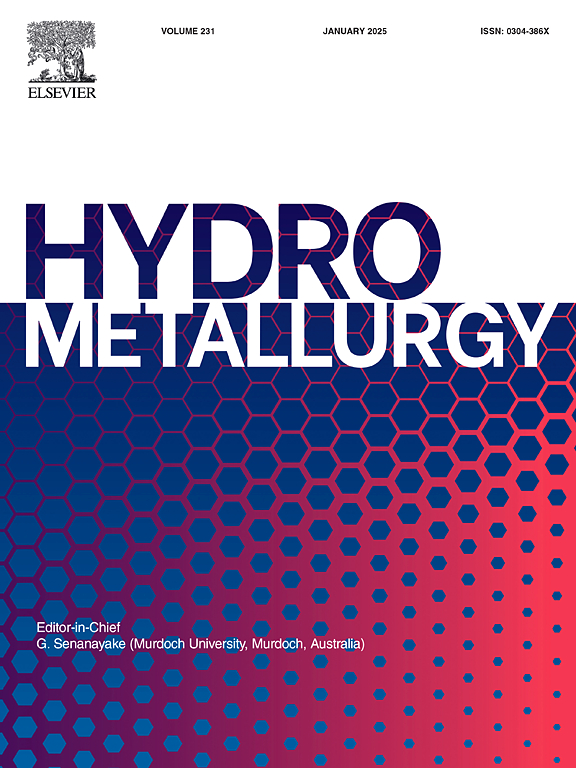Enhancement of mass transfer process in column leaching by graded combination of coarse–medium–fine (C–M–F) particle packing: Application to heap leaching of ion-adsorption type rare earth ore with mixed (NH4)2SO4 and NH4Cl solution
IF 4.8
2区 材料科学
Q1 METALLURGY & METALLURGICAL ENGINEERING
引用次数: 0
Abstract
The heap leaching of ion-adsorption type rare earth (RE) ores confronts the problems of the poor extent of leaching and high reagent consumption. This work explored the optimization of the mass transfer process by mixed-ammonium salt leaching of RE ore samples based on the column-packing order of particle size, chromatographic plate theory, and hierarchical column leaching experiments. Furthermore, the parameters of the mass transfer process during heap leaching with the mixed-ammonium salts were optimized. Additionally, the enhancement mechanism of the mass transfer process of the preferred hierarchical ore samples was identified using the Avizo software. Results indicated that a layered and graded combination of coarse–medium–fine (C–M–F) ore samples was the best for the RE leaching effect. The optimal leaching process parameters for RE were a molar ratio of 3:1 between (NH4)2SO4 and NH4Cl, ammonium ion concentration of 0.3 mol/L, leaching temperature of 303.15–313.15 K, pH of 4–6 for the leaching agent and flow rate of 0.5 mL/min. The diffusion channels of the solute in the C–M–F samples during leaching were more even than those in the raw ore samples. Meanwhile, its average pore pressure was relatively low. The research results can provide useful theoretical references and technical support for in-situ heap leaching of RE, gold, copper and other metal elements.
粗-中-细(C-M-F)颗粒分级组合强化柱浸传质过程:在(NH4)2SO4和NH4Cl混合溶液堆浸离子吸附型稀土矿中的应用
离子吸附型稀土矿堆浸面临浸出程度差、药剂用量大的问题。基于粒度柱填充顺序、色谱板理论和分层柱浸出实验,对稀土矿混合铵盐浸出传质过程进行优化研究。并对混合铵盐堆浸传质过程的参数进行了优化。此外,利用Avizo软件对优选分级矿样的传质强化机理进行了分析。结果表明,粗-中-细(C-M-F)矿样分层分级组合的稀土浸出效果最好。稀土的最佳浸出工艺参数为(NH4)2SO4与NH4Cl的摩尔比为3:1,铵离子浓度为0.3 mol/L,浸出温度为303.15 ~ 313.15 K,浸出剂pH为4 ~ 6,浸出流速为0.5 mL/min。浸出过程中,C-M-F样品中溶质的扩散通道比原矿样品更均匀。同时,其平均孔隙压力相对较低。研究结果可为稀土、金、铜等金属元素的原位堆浸提供有益的理论参考和技术支持。
本文章由计算机程序翻译,如有差异,请以英文原文为准。
求助全文
约1分钟内获得全文
求助全文
来源期刊

Hydrometallurgy
工程技术-冶金工程
CiteScore
9.50
自引率
6.40%
发文量
144
审稿时长
3.4 months
期刊介绍:
Hydrometallurgy aims to compile studies on novel processes, process design, chemistry, modelling, control, economics and interfaces between unit operations, and to provide a forum for discussions on case histories and operational difficulties.
Topics covered include: leaching of metal values by chemical reagents or bacterial action at ambient or elevated pressures and temperatures; separation of solids from leach liquors; removal of impurities and recovery of metal values by precipitation, ion exchange, solvent extraction, gaseous reduction, cementation, electro-winning and electro-refining; pre-treatment of ores by roasting or chemical treatments such as halogenation or reduction; recycling of reagents and treatment of effluents.
 求助内容:
求助内容: 应助结果提醒方式:
应助结果提醒方式:


